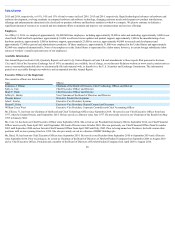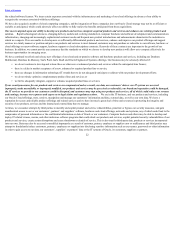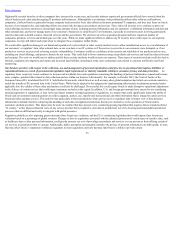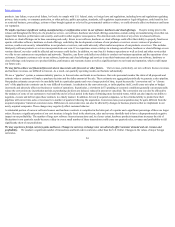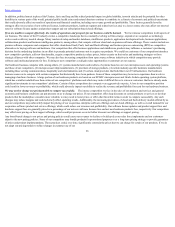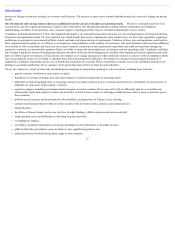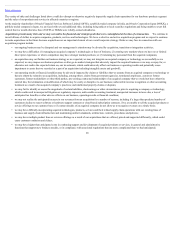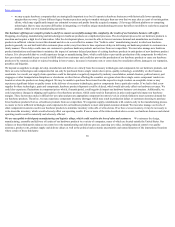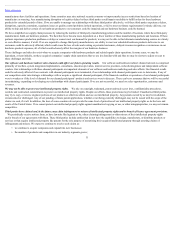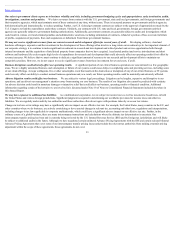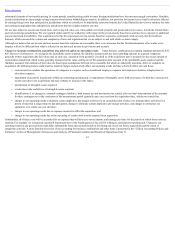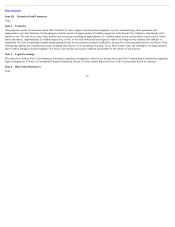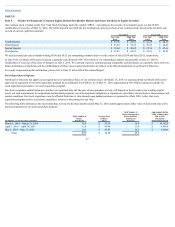Oracle 2015 Annual Report Download - page 30
Download and view the complete annual report
Please find page 30 of the 2015 Oracle annual report below. You can navigate through the pages in the report by either clicking on the pages listed below, or by using the keyword search tool below to find specific information within the annual report.
Table of Contents
The variety of risks and challenges listed above could also disrupt or otherwise negatively impact the supply chain operations for our hardware products segment
and the sales of our products and services in affected countries or regions.
As the majority shareholder of Oracle Financial Services Software Limited (OFSS), a publicly traded company in India, and Oracle Corporation Japan (NOKK), a
publicly traded company in Japan, we are faced with several additional risks, including being subject to local securities regulations and being unable to exert full
control that we would otherwise have if OFSS or NOKK were wholly-owned subsidiaries.
Acquisitions present many risks and we may not realize the financial and strategic goals that were contemplated at the time of a transaction. We continue to
invest billions of dollars to acquire companies, products, services and technologies. We have a selective and active acquisition program and we expect to continue
to make acquisitions in the future because acquisitions are an important element of our overall corporate strategy. Risks we may face in connection with our
acquisition program include:
• our ongoing business may be disrupted and our management’s attention may be diverted by acquisition, transition or integration activities;
• we may have difficulties (1) managing an acquired company’s technologies or lines of business; (2) entering new markets where we have no or limited
direct prior experience or where competitors may have stronger market positions; or (3) retaining key personnel from the acquired companies;
• an acquisition may not further our business strategy as we expected, we may not integrate an acquired company or technology as successfully as we
expected, we may impose our business practices or alter go-to-market strategies that adversely impact the acquired business or we may overpay for, or
otherwise not realize the expected return on, our investments, which could adversely affect our business or operating results and potentially cause
impairment to assets that we recorded as a part of an acquisition including intangible assets and goodwill;
• our operating results or financial condition may be adversely impacted by claims or liabilities that we assume from an acquired company or technology or
that are otherwise related to an acquisition, including, among others, claims from government agencies, terminated employees, current or former
customers, former stockholders or other third parties; pre-existing contractual relationships of an acquired company that we would not have otherwise
entered into, the termination or modification of which may be costly or disruptive to our business; unfavorable revenue recognition or other accounting
treatment as a result of an acquired company’s practices; and intellectual property claims or disputes;
• we may fail to identify or assess the magnitude of certain liabilities, shortcomings or other circumstances prior to acquiring a company or technology,
which could result in unexpected litigation or regulatory exposure, unfavorable accounting treatment, unexpected increases in taxes due, a loss of
anticipated tax benefits or other adverse effects on our business, operating results or financial condition;
• we may not realize the anticipated increase in our revenues from an acquisition for a number of reasons, including if a larger than predicted number of
customers decline to renew software or hardware support contracts or cloud-based subscription contracts, if we are unable to sell the acquired products or
service offerings to our customer base or if contract models of an acquired company do not allow us to recognize revenues on a timely basis;
• we may have difficulty incorporating acquired technologies, products, services and their related supply chain operations with our existing lines of
business and supply chain infrastructure and maintaining uniform standards, architecture, controls, procedures and policies;
• we may have multiple product lines or services offerings as a result of our acquisitions that are offered, priced and supported differently, which could
cause customer confusion and delays;
• we may have higher than anticipated costs in continuing support and development of acquired products or services, in general and administrative
functions that support new business models, or in compliance with associated regulations that are more complicated than we had anticipated;
28




